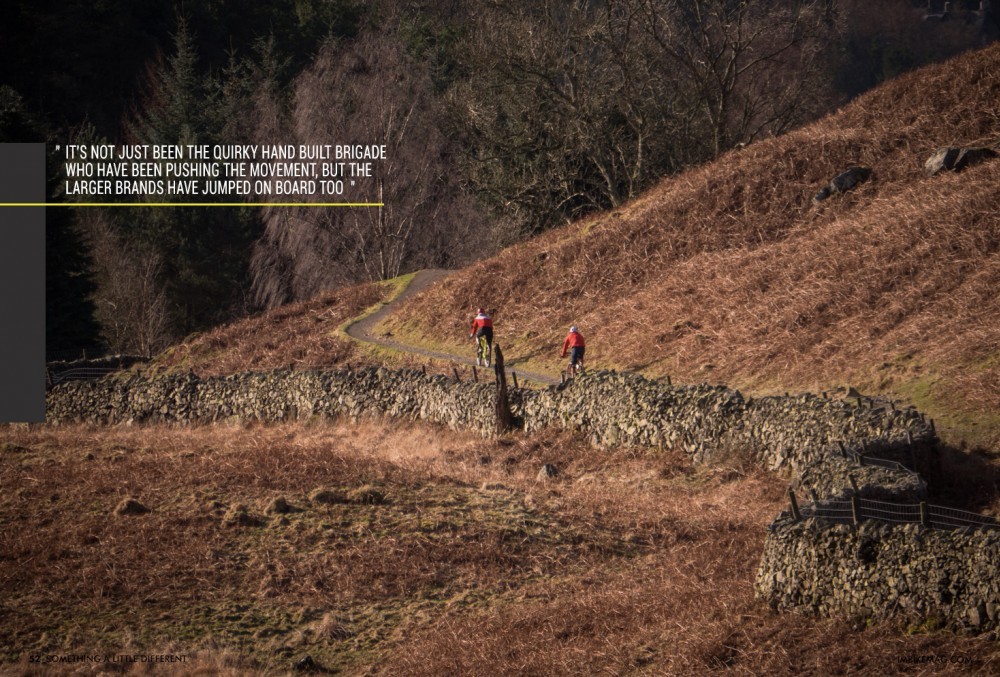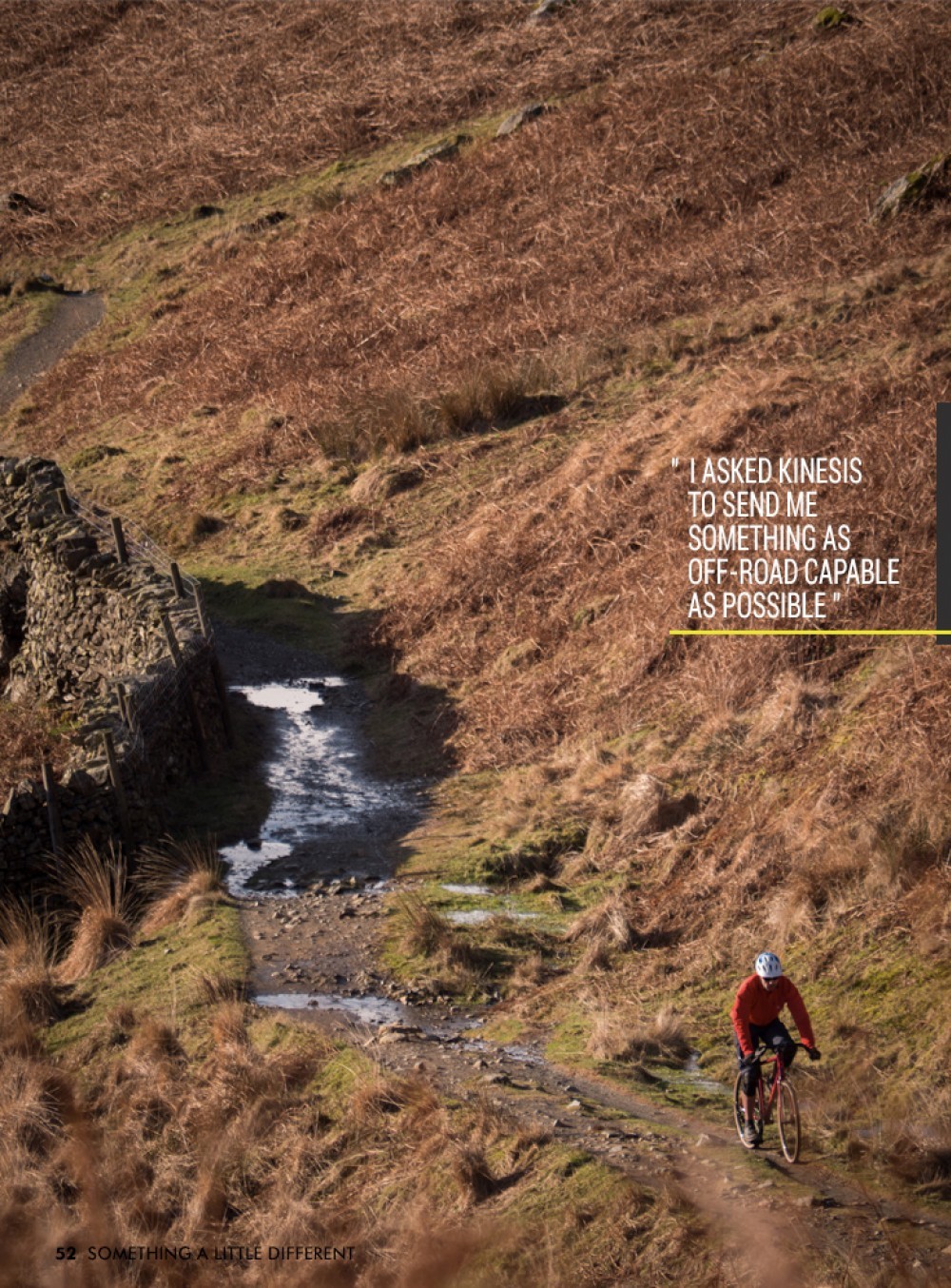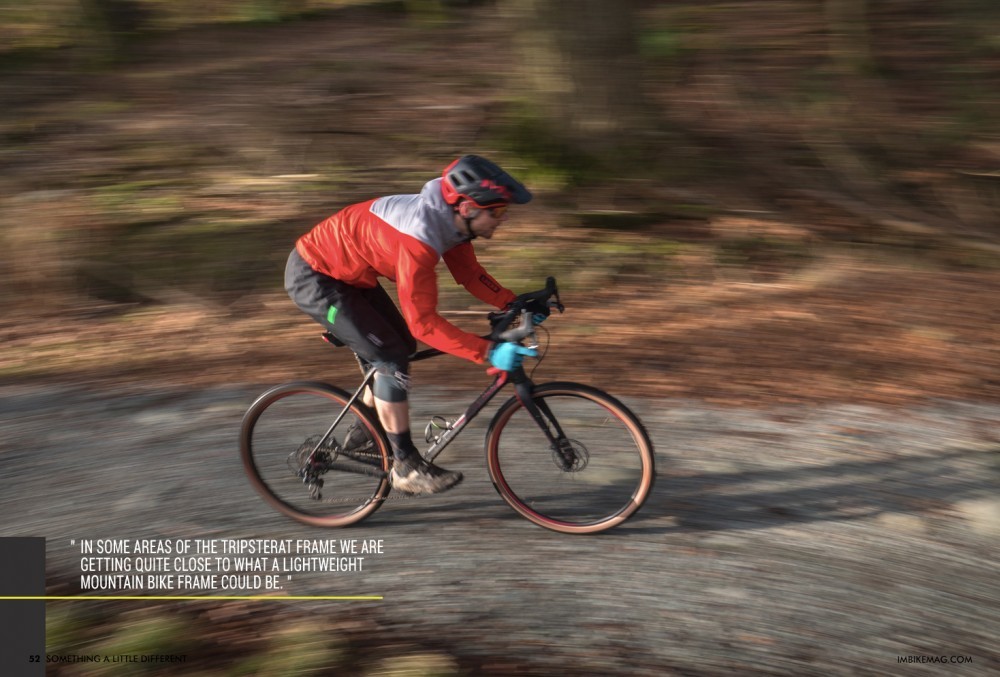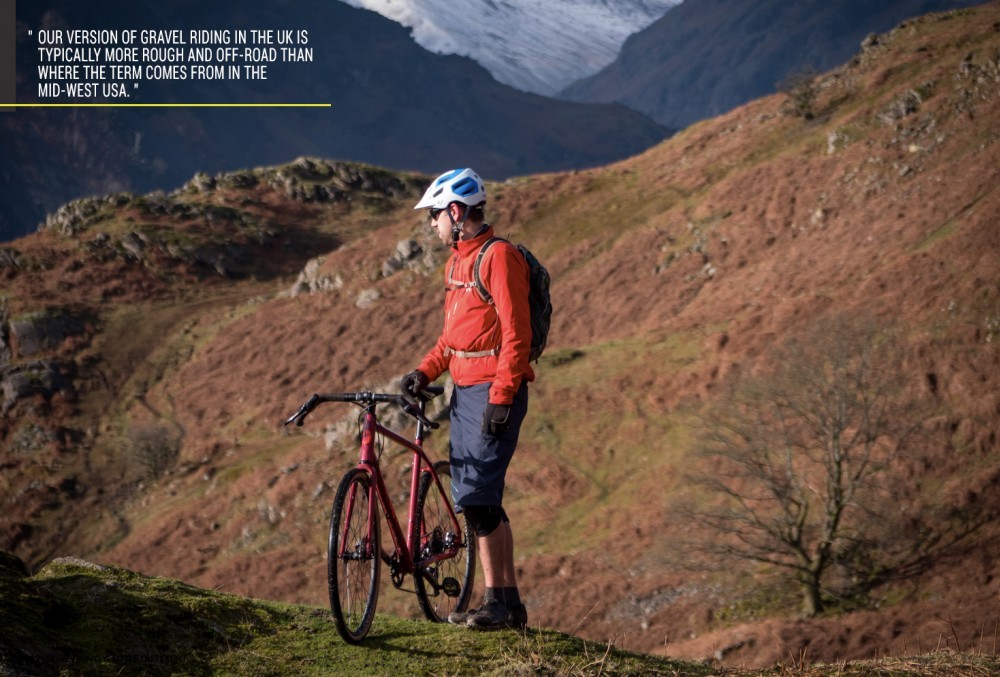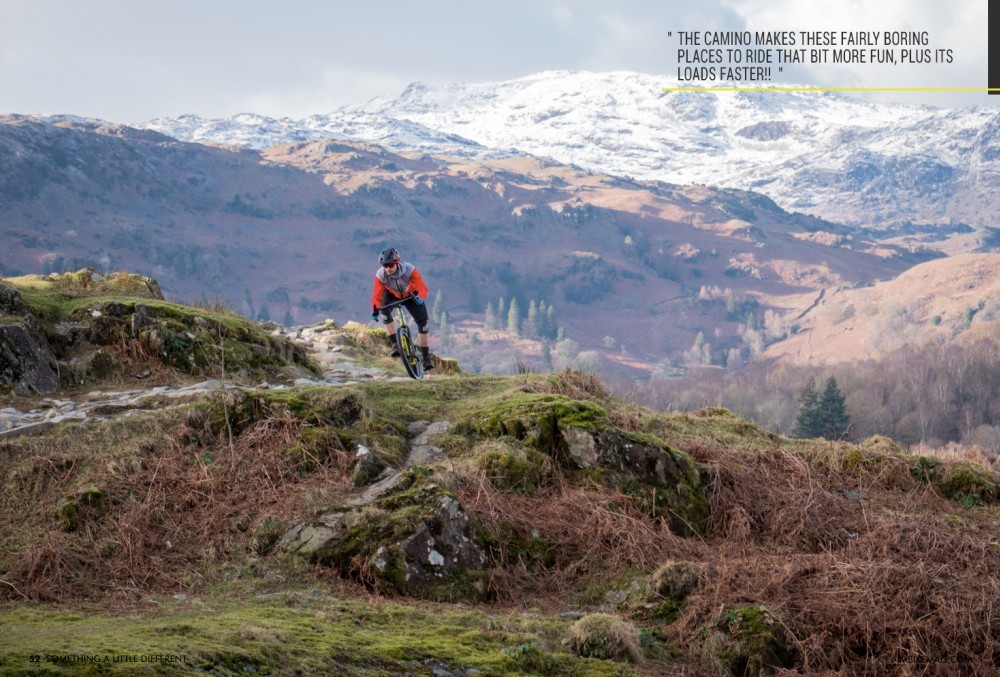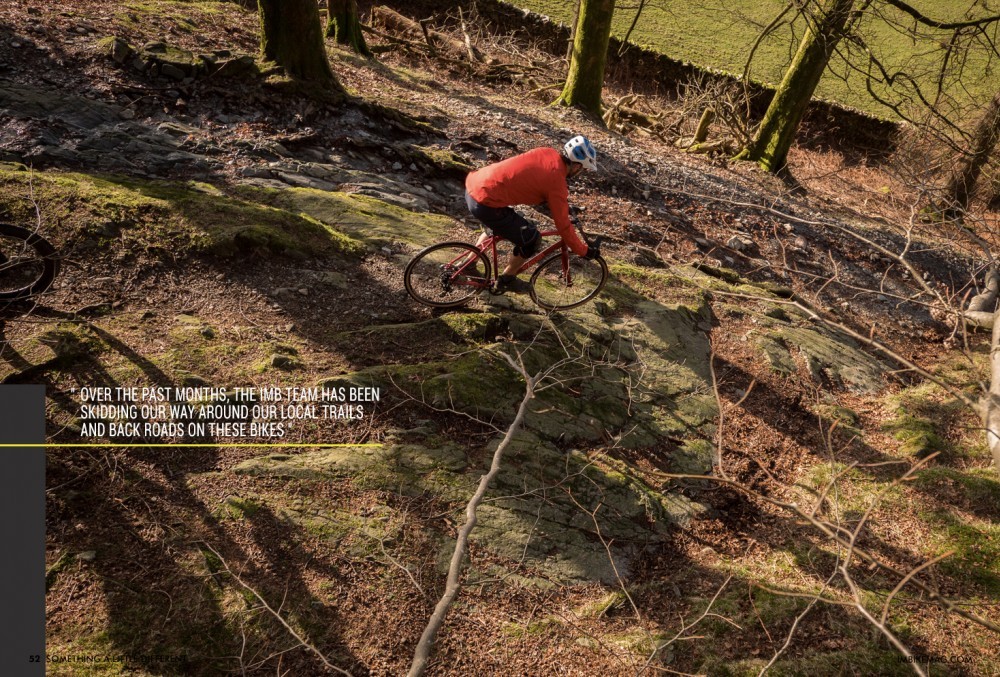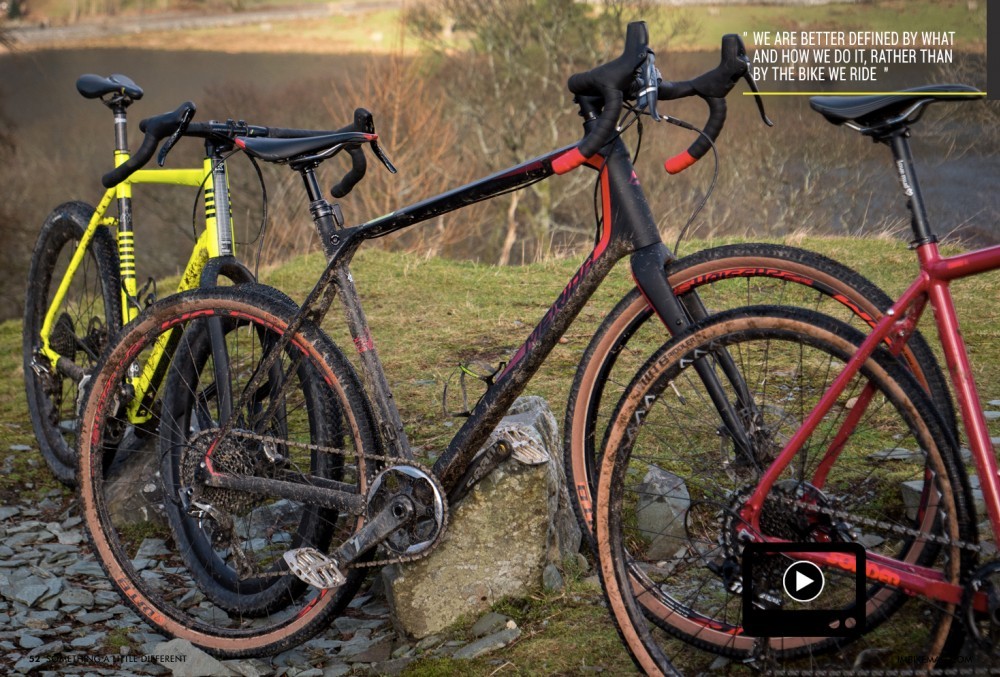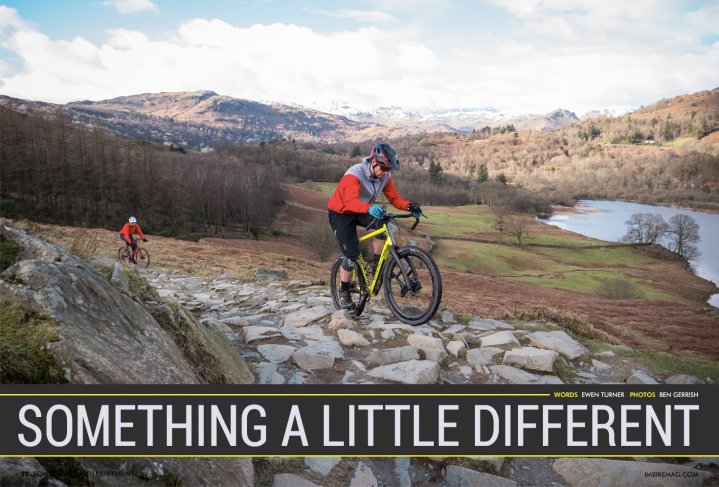
Something A Little Different
Issue 52 / Mon 26th Feb, 2018
Don't be afraid; they are still bikes after all. We take a look at the rapidly growing 'gravel' bike market and wonder if they are just mountain bikes with curly handlebars. Hitting the trails, we see what they are capable of and talk to the people who make them about why they are so good.
While some people fear change, others actively embrace it, usually it is the trailblazers who get rewarded with their early adoption. Ewen Turner is one of those pioneers, Gravel Bikes have been on his radar for a while, have you seen any out on your trails yet? Here’s his take on this new niche style of ride coming to your local woods soon, or maybe they are there already!
Maybe Tomac had it right
John Tomac never let a set of handlebars dictate what he wanted to ride. A legend in BMX, mountain bike and on the road, he found success on any two-wheeled machine. Racing world cup downhill on drop bars to keep consistency between his bikes, he was a force to be reckoned with.
In these days of multi-niche mountain biking, we like to draw lines between the sub-genres, defining bikes through travel, or head angles, but drop bars seem very un-mountain bike. They are for riding on the road, maybe for cyclocross but proper off road, surely not?
Recently the rise of the so-called “gravel bike” has been hard to ignore, for some it is an excuse to create a whole new genre, with its own style, fashion and media outlets. For me, it still looks like a bike, and if you're riding off-road, then hey, I'm down with that.
It's not just been the quirky hand built brigade who have been pushing the movement, but the larger brands have jumped on board too, adding weight to the movement. The rise of bike packing and the increased visibility in the media of long distant self-supported races such as the Tour Divide and the Highland Trail 550 has got people thinking differently about riding bikes for huge distances. Finally sealing the deal is when brands usually militantly focused on gravity biking release a drop bar bike, such as Nukeproof or NS.
With this in mind, and challenging my inner Tomac, I gathered a handful of what I might call drop bar mountain bikes and went riding. Not just on the road or gravel, but actual mountain biking and aimed to see what they could do.
What are these things?
The most recognisable feature of these types of bike is the handlebars or curly wurly bars as Chris Akrigg once said, but they didn't seem to slow him down! 650B, 700c, it matters not, and many can take either. Dropper posts? Why not? 1x drivetrains? But of course, and hydraulic disc brakes are de rigueur. It's all looking pretty mountain bike to me.
I asked Kinesis to send me something as off-road capable as possible, and the monster that arrived was incredible. Taking their new TripsterAT frame, they gave it a Lauf suspension fork, slid in some 650b carbon wheels and shod it in 1.9-inch rubber. It's a mountain bike, but not as we know it, well, unless you grew up riding bikes in the 80s and 90s.
The Merida Silex is a pretty genre-spanning bike, able to be built up in many different guises. It was Merida who initially tempted me with a 'mountain bikers road bike' but then showed me how it could be built up. Our build was stock but we swapped out the tyres for some Maxxis Ravagers and swapped between them and some WTB Riddlers. We also found a dropper post that would work from Brand X giving 125mm of drop and external routing, which although old school is great if your frame hasn't got internal routing.
From Sonder, we have the Camino, which is a stock bike ready to do all things gravel and beyond. The frame has been in the line up a little while, and whilst it is available in Titanium, it's the steel version that we've been pedalling. Coming with high volume 700c tyres and flared drops, it's clear that these folks know what’s needed for getting away from the roads
The History
We know that John Tomac did what the hell he liked and we loved him for it, but how have we got to this point where these bikes are in focus. Cyclocross bikes share a lot of common ground with the mountain bike, and both spend plenty of time in the mud, but they look very different. One of the main reasons that drop bar bikes have stayed very specialised is that cyclocross bikes are restricted, or preserved by rules. Bars must be narrow, tyres must be narrow and until recently brakes needed to be cable operated rim brakes. For racing this kept things on a level, but didn't allow the terrain to dictate the technology, or for the bikes to develop.
More recently, when 29inch wheels came about, there were various 'monster cross' bikes rolling around, and experiments with funky bars were not uncommon. Roll forward a few more years, and riders were experimenting and discovering that if a cyclocross bike had bigger volume tyres, brakes that worked and some wide bars, things suddenly became a bit more realistic for riding off-road. I caught up with a couple of folks who know their gravel from their pebbles…
Rory Hitchens Marketing and Senior Brand Manager, Upgrade/Kinesis
The gravel market (let's call it that for now) is growing. What do you think is driving it? Is it adventurous roadies or mountain bikers?
I think your question is who is driving it, and my impression is the adventurous roadie. I think mountain bike riders who want to go off-road bike packing will do it on a mountain bike.
However, if your mountain bike habit is very full suspension focused then the more “beyond-gravel” (off-road capable) gravel bikes like our TripsterAT offer a very good second bike alternative to the traditional hardtail second bike, and will double up as a winter road bike as well as giving that option for larger loops of mixed terrain exploration.
If your question were what is driving it, then I would say the tyre companies in particular. They make it possible to design bikes around new sizes and widths and volumes of tyre that open up the possibilities of the bikes. We would not have made the TripsterAT so off-road capable if the choice of 700x45c tyres had not come back to the market after a 25yr gap.
How does the TripsterAT differ from just a lightweight mountain bike?
It’s true to say that in some areas of the TripsterAT frame we are getting quite close to what a lightweight mountain bike frame could be. For example, the down tube profile was originally designed as part of a mountain bike tube-set but we have made it lighter with thinner material for the AT. However, it still passes the industry CEN test for mountain bike frames.
But there are key differences still:
Geometry – designed around a drop bar set up so the Top Tube is shorter. Allows you to get into the drops comfortably. This makes you faster due to aerodynamics when you want to chip along on the roads or faster trails.
Head Angle – not as slack as MTB as not designed for longer (suspension) forks
BB Drop – lower than on an MTB
BB Shell – 68mm rather than 73mm as we do not expect as much rear tyre clearance as an MTB.
Taller head tubes and flatter top tubes – larger main triangle helps with bottles and frame bag capacity
Is 'Gravel Bike' the best term for a bike such as the TripsterAT? (Can I just call it a drop bar mountain bike?)
I think the TripsterAT, even in this capable build, still has limits off-road and for that reason, I don’t think it should be called a drop bar mountain bike. Mountain biking now, for most, means full suspension and proper tech trail riding which The Tripster is not suited to.
Because we knew our TripsterAT was more capable than many of the generic Gravel or All-Road bikes that are coming out now from other brands, we have used “Beyond Gravel” as a way to explain that our design is more capable and confident off-road.
We can all create terms and pigeon holes if we want to and the industry likes to help consumers understand a product’s purpose with naming as a style of riding that the bike is for. However, our version of Gravel riding in the UK is typically more rough and off-road than where the term comes from in the mid-west USA. I think Gravel is a nice term to use for now and helps people think about the style of riding they are doing.
What sort of rider buys a drop bar mountain/adventure/gravel bike and what sort of riding do they do?
A rider that wants the versatility of a bike that will give a range of handlebar positions and allow comfort and speed over distances on road yet with the capability of detouring onto bridleways and permissive tracks, extending the adventure by bike.
Neil Sutton Sonder Product Manager
What is a Gravel bike? Do we need any more bike niches?
A gravel bike is probably one of the most versatile bikes you can own, on slicks, it’ll carry a decent road pace, stick some knobblies on it and it’ll give a 29er XC bike a run for its money! I think it could be the perfect niche; these bikes can cover so many bases you’ll wonder what you ever did without one!
How relevant are these bikes to mountain bikers? It's still a bike for riding off-road, so it's a mountain bike?
As a mountain biker the only bike I currently own is my Camino (Titanium Force1 with tan wall tyres, god its nice!), I’m quite lucky in that I have plenty of MTB’s at my disposal and can always find something to suit where I want to ride, but if a few hours just want to get out the Camino is perfect for riding from my door. I’ve no decent MTB trails on my doorstep, just a bit of flat woodland and miles of farm tracks and back lanes so riding out on a mountain bike is pretty miserable, the Camino makes these fairly boring places to ride that bit more fun, plus its loads faster!! I think it can be a mountain bike (like Tomac’s old drop bar race bike) but can also be a road bike,
Why would a bike like this be better than a carbon hardtail?
Speed. The gearing on these things coupled with the lighter overall weight just makes them faster than MTB’s, that and the versatility. A carbon hardtail is never going to be great on the road, Slicks on a Camino makes it pretty much a road bike and if you leave the knobblies on its going to be able to hang with an XC bike a lot longer than you’d expect. I’d also say comfort over distance; the Camino’s relatively upright riding position is going to be much nicer over a few days than that of an XC race bike.
What is the Camino designed for, and what does it do well and why?
The Camino was designed to be a comfortable long-distance bike that would excel on a variety of terrain. It’s a bit more relaxed than most gravel bikes, as they are still technically race bikes, that relaxed position gives you the confidence to push it hard no matter where you’re riding, on or off road and just feels that bit more surefooted when the trails get rough. I honestly don’t think I’ve ever ridden a bike that is so good at such a broad range of things!
How to maximise fun
Over the past months, the IMB team has been skidding our way around our local trails and back roads on these bikes to see what they could do and learnt a lot about how to get the best from them as mountain bikers. First off, bigger tyres are better, and as we have learnt, the tyre industry has been crucial to the development of these bikes. 700/45c tyres are a game changer for big wheels and allow for more comfort, bigger contact patches for disc brakes to work and inspire confidence. Furthermore, if you can get 650b wheels in the frame, then this allows for bigger tyres again with a similar outer circumference, this was our favourite setup for getting off the road, and there wasn't a hugely noticeable difference in rolling resistance.
Up front, it was flared drops that really had us surprised, thinking they were just a quirky, beard stroking addition; they are fundamental to the stability of handling in the rough. With a wider stance and brakes at a more comfortable angle, they give far more control whilst still allowing a low front end for punching a hole through a headwind.
Elsewhere, all the things you'd like on a mountain bike transfer over, and having decent disc brakes and a simple one-by drivetrain just work. As far as dropper posts go, as a tall rider, I think they work just as well on a gravel bike, but I tended to use them less regularly but still needed to access the lever rapidly. Mounting on the top bar didn't work too well, so ideally in the future, a left-hand brake lever with an integrated dropper lever would be excellent. The other consideration is seat height, as the long seat tubes can push it too high in the top position.
For maximum fun, we found long rides were where these bikes really shone, being able to link sections of trail which would usually be out of reach on a big bike. Suddenly the potential distance possible from your front door increases and new adventures are possible. You can't ride as loose or get involved in big mountain terrain, but for tearing down singletrack or challenging your riding skills while pushing fitness, they are ideal. Despite the long distance focus, an hours burn from the front door can get me to my local trails and back faster than ever before, giving me more time on a bike, and crucially, more time off road with a smile on my face.
For me, we are better defined by what and how we do it, rather than by the bike we ride, we didn't all have mountain bikes as kids yet we still went mountain biking. Don't get hung up on labels, it's still just a bike. Now, where's my credit card?
Thanks to Neil Sutton from Sonder and Rory Hitchens from Upgrade/Kinesis and Mike Wilkins from Merida
Videos
By Ewen Turner
Ewen Turner is a self-confessed bike geek from Kendal in the Lake District of England. He runs a coaching and guiding business up there and has a plethora of knowledge about bikes with an analytical approach to testing. His passion for bicycles is infectious, and he’s a ripper on the trails who prefers to fit his working life around his time on the bike.




